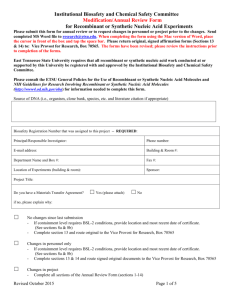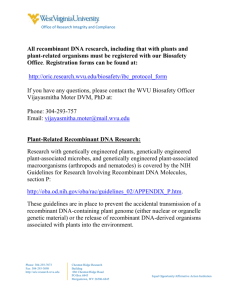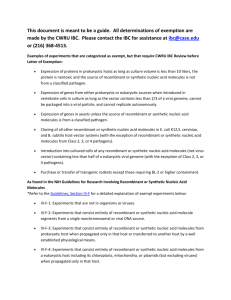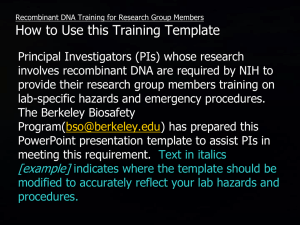REFERENCES - East Tennessee State University
advertisement
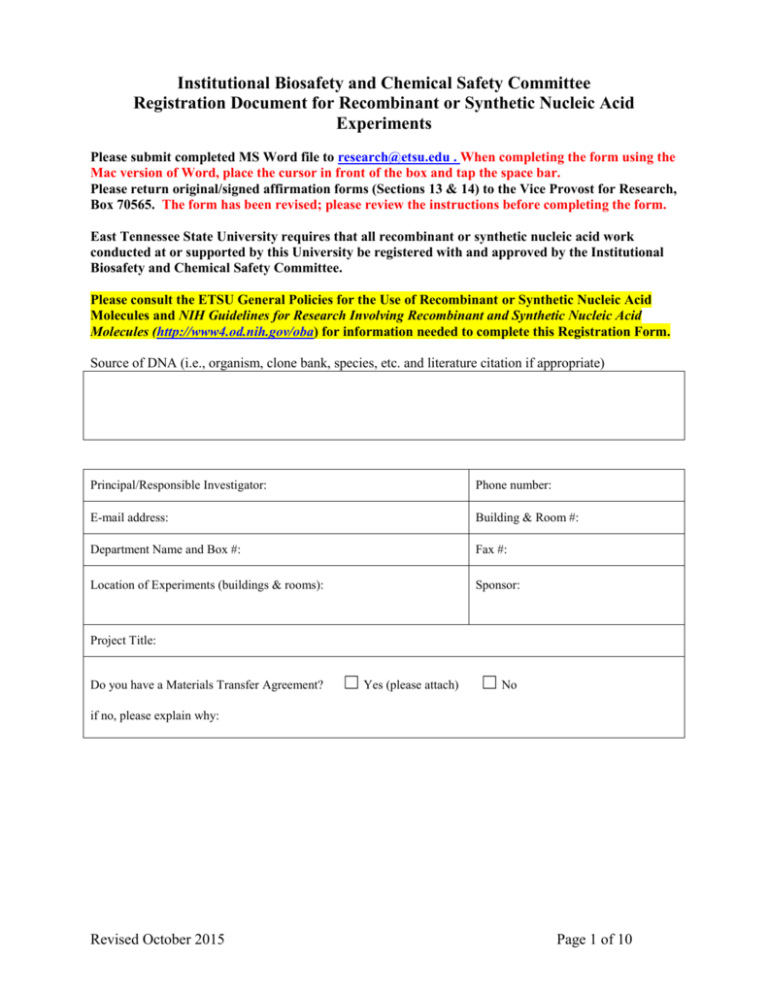
Institutional Biosafety and Chemical Safety Committee Registration Document for Recombinant or Synthetic Nucleic Acid Experiments Please submit completed MS Word file to research@etsu.edu . When completing the form using the Mac version of Word, place the cursor in front of the box and tap the space bar. Please return original/signed affirmation forms (Sections 13 & 14) to the Vice Provost for Research, Box 70565. The form has been revised; please review the instructions before completing the form. East Tennessee State University requires that all recombinant or synthetic nucleic acid work conducted at or supported by this University be registered with and approved by the Institutional Biosafety and Chemical Safety Committee. Please consult the ETSU General Policies for the Use of Recombinant or Synthetic Nucleic Acid Molecules and NIH Guidelines for Research Involving Recombinant and Synthetic Nucleic Acid Molecules (http://www4.od.nih.gov/oba) for information needed to complete this Registration Form. Source of DNA (i.e., organism, clone bank, species, etc. and literature citation if appropriate) Principal/Responsible Investigator: Phone number: E-mail address: Building & Room #: Department Name and Box #: Fax #: Location of Experiments (buildings & rooms): Sponsor: Project Title: Do you have a Materials Transfer Agreement? ☐ Yes (please attach) ☐ No if no, please explain why: Revised October 2015 Page 1 of 10 INSTRUCTIONS: 1. If your recombinant or synthetic nucleic acid experiment meets the definition of any of the exempt classes described in Section 1 of the ETSU General Policies for the Use of Recombinant or Synthetic Nucleic Acid Molecules and the NIH Guidelines (Section III-F; Appendix A, Appendix C) – answer questions numbers 1 and 2, on pages 2 & 3. Please include the reasons for requesting an exempt determination. Print out a hard copy, sign and return this registration to: Chair, Recombinant and Synthetic Nucleic Acid Subcommittee of the ETSU Biosafety and Chemical Safety Committee, Box 70565. 2. If your recombinant or synthetic nucleic acid experiment does not meet the definition of exempt, proceed to page 4, answer all questions. Print out a hard copy, sign and return to: Chair, Recombinant or Synthetic Nucleic Acid Subcommittee of the ETSU Biosafety and Chemical Safety Committee, PO Box 70565. EXEMPT RECOMBINANT AND SYNTHETIC NUCLEIC ACID EXPERIMENTS Experiments designated “Exempt” by NIH. 1. Please provide the following information (see Appendix B for an example): SOURCE (S) OF DNA HOST(S) VECTOR(S) EXPERIMENTAL USE* *Please describe the intended application of the Recombinant and Synthetic Nucleic Acid molecule. If your intent is to express a certain gene (protein), please indicate which gene. Refer to the Reference Section, Appendix A for examples. Revised October 2015 Page 2 of 10 2. In 50 words or less, please describe your research objectives. I have read the ETSU General Policies and the NIH Guidelines pertaining to use of Recombinant and Synthetic Nucleic Acid Molecules and verify that all uses listed herein are classified as exempt. I acknowledge my responsibility for the conduct of this research in accordance with Section IV-B-7 of the NIH Guidelines. ______________________________ Principal Investigator (signature) ___________________ Date ______________________________ Chairperson, Biosafety and Chemical Safety Committee (signature) ___________________ Date Revised October 2015 Page 3 of 10 NON-EXEMPT RECOMBINANT AND SYNTHETIC NUCLEIC ACID REGISTRATION 1. Please check any of the following that pertain to this experiment. Please note: this category may require additional information to be submitted with the registration, contact the Chair of the Recombinant and Synthetic Nucleic Acid Subcommittee of the ETSU Biosafety and Chemical Safety Committee for further information. ☐ Expression of toxic products ☐ Use of transgenic animals ☐ Use of transgenic plants ☐ Experiment will involve more than 10 liters of culture 2. Check the category (a, b, or c) of Recombinant or Synthetic Nucleic Acid experiments you wish to perform (check all that apply). ☐ a. Experiments that require committee notice at the time of initiation (ETSU General Policies Section 2 and NIH Guidelines Section III-E). Please include a brief description of the experimental plan and indicate the relevant section of the NIH Guidelines. ☐ b. Experiments that require approval by this committee before initiation (ETSU General Policies Section 3 and NIH Guidelines Section III-D). ☐ Experiments using an adenovirus or retrovirus vector Experiments using human or animal pathogens (Risk Groups 2, 3, or 4 ) as host-vector systems Experiments in which DNA from human or animal pathogens is cloned in nonpathogenic prokaryotic or lower eukaryotic host-vector systems Experiments involving the use of infectious animal or plant viruses or defective viruses in the presence of helper virus in a tissue culture system Experiments involving whole animals or plants c. Experiments that require specific approval by both NIH and this committee before initiation (ETSU General Policies Sections 4, 5, 6 and NIH Guidelines Section III-A, B, C). Please note: this category requires additional information to be submitted with the registration, contact the Chair of the Recombinant or Synthetic Nucleic Acid Subcommittee of the ETSU Biosafety and Chemical Safety Committee for further information. Deliberate cloning of genes for highly toxic products Deliberate release of recombinant organisms to the environment Transfer of drug-resistance if such transfer might compromise use of drug therapeutically Transfer of Recombinant or Synthetic Nucleic Acid to humans including gene therapy For work in all three categories above, please describe the following areas in detail: 3. Source of DNA(s) or Synthetic Nucleic Acids (i.e., organism, clone bank, species, etc., and literature citation if appropriate). 4. Nature if Inserted Sequence (genomic cDNA, PCP products etc.) Revised October 2015 Page 4 of 10 5. Specific Host(s) 6. Specific Vector(s) 7. List the Risk Group for your source or vector (Defined in Appendix B of the NIH Guideline or Appendix C of this form) 8. List the Containment Level (Defined in Appendix G of the N IH Guidelines or Appendix C of this form): Biosafety Level (BL) BL- If BL-2, give a) the location and b) the date of certification. 9. Will the studies include deliberate attempts to obtain expression of a foreign gene (a gene originally exogenous to the host-vector system used)? ☐ Yes ☐ No If yes, what protein will be produced? 10. Does this research protocol require either ETSU IRB or ETSU Animal Care Committee approval? If yes, which? 11. List the names of all personnel participating in this study and have them initial by their names to indicate that they have read and understand the nature of these experiments and that they can safely and properly handle the material described (add more rows if necessary). NAME Revised October 2015 TITLE Page 5 of 10 12. Please submit with this application, a maximum-one-page description of the experimental methodology and containment procedures. Revised October 2015 Page 6 of 10 13. Principal Investigator’s Affirmation I acknowledge my responsibility for the conduct of this research in accordance with Section IV-B-7 of the NIH Guidelines. I accept responsibility for the safe conduct of work with this material and have received the appropriate training on the hazards and the level of containment required to perform this research safely. I will report to Biosafety and Chemical Safety Committee any accident or incident that results in a potentially toxic exposure to personnel or any incident releasing Recombinant and Synthetic Nucleic Acid or other potentially hazardous materials into the environment. _____________________________ Principal Investigator (signature) __________________ Date _____________________________ Chairperson, Biosafety and Chemical Safety Committee (signature) __________________ Date 14. Project Personnel Affirmation I accept responsibility for the safe conduct of work with this material and have received the appropriate training on the hazards and the level of containment required to perform this research safely. I will report to the Principal Investigator and the Biosafety and Chemical Safety Committee any accident or incident that results in a potentially toxic exposure to personnel or any incident releasing Recombinant and Synthetic Nucleic Acid or other potentially hazardous materials into the environment _____________________________ Project Personnel (signature) __________________ Date _____________________________ Chairperson, Biosafety and Chemical Safety Committee (signature) __________________ Date (Print this page as many times as necessary to allow for signatures for all personnel listed in Number 11.) Revised October 2015 Page 7 of 10 REFERENCES APPENDIX A: ETSU General Policies for the Use of Recombinant and Synthetic Nucleic Acid The Recombinant and Synthetic Nucleic Acid Subcommittee of the ETSU Biosafety and Chemical Safety Committee has responsibility for reviewing all experimentation that involves the use of Recombinant and Synthetic Nucleic Acid and recommending the appropriate course of action to the Biosafety and Chemical Safety Committee for a decision. The Biosafety and Chemical Safety Committee functions on behalf of ETSU in matters of compliance with applicable federal and state regulations regarding the use of Recombinant and Synthetic Nucleic Acid. The National Institutes of Health (NIH) has grouped Recombinant and Synthetic Nucleic Acid experiments into the following six categories. The non-exempt categories described in Section 2 through 6 are subject to oversight by the Recombinant and Synthetic Nucleic Acid Subcommittee. Experiments covered by the NIH Guidelines for Recombinant or Synthetic Nucleic Acid Section 1. Exempt Experiments – The following Recombinant and Synthetic Nucleic Acid molecules are exempt from the NIH Guidelines and registration with the Biosafety and Chemical Safety Committee is not required. (Section III F) http://oba.od.nih.gov/rdna/nih_guidelines_new.htm#_Toc331174008 Section 2. Experiments that require ETSU Biosafety and Chemical Safety Committee Notice Simultaneous with Initiation of the Experiment. (Section III E) http://oba.od.nih.gov/rdna/nih_guidelines_new.htm#_Toc331174004 Section 3. Experiments that Require ETSU Biosafety and Chemical Safety Committee Approval Before Initiation Section III D) http://oba.od.nih.gov/rdna/nih_guidelines_new.htm#_Toc331173996 Section 4. Experiments that Require Institutional Biosafety and Chemical Safety Committee Approval, Approval of the Recombinant and Synthetic Nucleic Acid Advisory Committee (RAC) of the NIH, and NIH Director Approval Before Initiation Section III A) http://oba.od.nih.gov/rdna/nih_guidelines_new.htm#_Toc331173989 Section 5. Experiments that Require NIH/Office of Biotechnology Activities (OBA) and Institutional Biosafety and Chemical Safety Committee Approval Before Initiation. Section III B) http://oba.od.nih.gov/rdna/nih_guidelines_new.htm#_Toc331173991 Section 6. Experiments that Require ETSU Biosafety and Chemical Safety Committee and Institutional Review Board Approvals and RAC Review Before Research Participant Enrollment (Section III C) http://oba.od.nih.gov/rdna/nih_guidelines_new.htm#_Toc331173994 Revised October 2015 Page 8 of 10 APPENDIX B: Question #1 – Example of a Completed Exempt Recombinant and Synthetic Nucleic Acid Table Source(s) of DNA HOST(S) VECTOR(S) EXPERIMENTAL USE* Cloning, sequencing Major histocompatibility complex class II (mouse) E. coli (K-12) Plasmid, Bluescript, E. coli pET21 Overexpression of protein in E. coli for structure/function Yeast pDHIL cDNA (human) E. coli Lambda gt10 Heme B3-8 gene (human) Promotor of BMP2 (mouse) E. coli pUC19 Overexpression of protein in yeast for structure/function cDNA Library, screen for clones PCR amplification E. coli F9 cells (mouse) Nitric oxide synthase (bovine) Galactosidase (LacZ gene), (E. coli) E. coli Insect cells (SF9) E. coli Reporter plasmid, pGL2-promotor (luciferase) Plasmid, pFASTBAC. Baculovirus, AcNPV Plasmid, pUB110, pS194,pT127 Transient infections to study promoter activity Overexpression of protein in insect cells Gene expression (northerns, attenuation studies) *Please describe the intended application of the Recombinant and Synthetic Nucleic Acid molecule. If your intent is to express a certain gene (protein), please indicate which gene. Refer to the Reference Section, Appendix A, for examples. APPENDIX C: Definitions of Risk Group and Biosafety Level(s). As researchers, it is extremely important to consider all of the possible health risks (real and theoretical) associated with the use of Recombinant and Synthetic Nucleic Acid molecules or infectious agents. The result of careful planning prior to the initiation of a project using these agents will allow the researcher to select the proper physical containment application(s) (referred to as Biosafety Levels) thereby decreasing the risk of an accidental exposure to the staff, general public, and the environment. Therefore, one of the top priorities of a researcher should be to familiarize him/herself with the terminology and definitions commonly applied to these two important areas – Risk and Containment. These definitions are provided for you below. Revised October 2015 Page 9 of 10 Risk Group is classified into four categories (NIH Guidelines for Research Involving Recombinant and Synthetic Nucleic Acid Molecules): Risk Group 1 (RG1) agents are not associated with disease in healthy adult humans. Risk Group 2 (RG2) agents are associated with human disease which is rarely serious and for which preventive or therapeutic interventions are often available. Risk Group 3 (RG3) agents are associated with serious or lethal disease for which preventive or therapeutic interventions may be available. Risk Group 4 (RG4) agents are likely to cause serious or lethal human disease for which preventive or therapeutic interventions are not usually available. Biosafety Level is classified into the following groups (Biosafety in Microbiological and Biomedical Laboratories): Biosafety Level 1 (BL 1) is suitable for work involving well-characterized agents not known to cause disease in healthy adult humans, and of minimal potential hazard to laboratory personnel and the environment. The laboratory is not necessarily separated from the general traffic patterns in the building. Work is generally conducted on open bench tops using standard microbiological practices. Special containment equipment or facility design is not required nor generally used. Laboratory personnel have specific training in the procedures conducted in the laboratory and are supervised by a scientist with general training in microbiology or a related science. Biosafety Level 2 ((BL 2) is similar to Level 1 and is suitable for work involving agents of moderate potential hazard to personnel and the environment. It differs in that (1) laboratory personnel have specific training in handling pathogenic agents and are directed by competent scientists, (2) access to the laboratory is limited when work is being conducted, (3) extreme precautions are taken with contaminated sharp items, and (4) certain procedures in which infectious aerosols or splashes may be created are conducted in biological safety cabinets or other physical containment equipment. Biosafety Level 3 (BL 3) is applicable to clinical, diagnostic, teaching, research, or production facilities in which work is done with indigenous or exotic agents which may cause serious or potentially lethal disease as a result of exposure by the inhalation route. Laboratory personnel have specific training in handling pathogenic and potentially lethal agents, and are supervised by competent scientists who are experienced in working with these agents. All procedures are conducted within biological safety cabinets or other physical containment devices, or by personnel wearing appropriate personal protective clothing and equipment. The laboratory has special engineering and design features. Biosafety Level 4 (BL 4) is required for work with dangerous and exotic agents which pose a high individual risk of aerosol-transmitted laboratory infections and life-threatening disease. Restrictions apply to personnel training, lab accessibility and construction, and the use of protective equipment and clothing. Recombinant and Synthetic Nucleic Acid Policies Revised October 2015 Page 10 of 10
